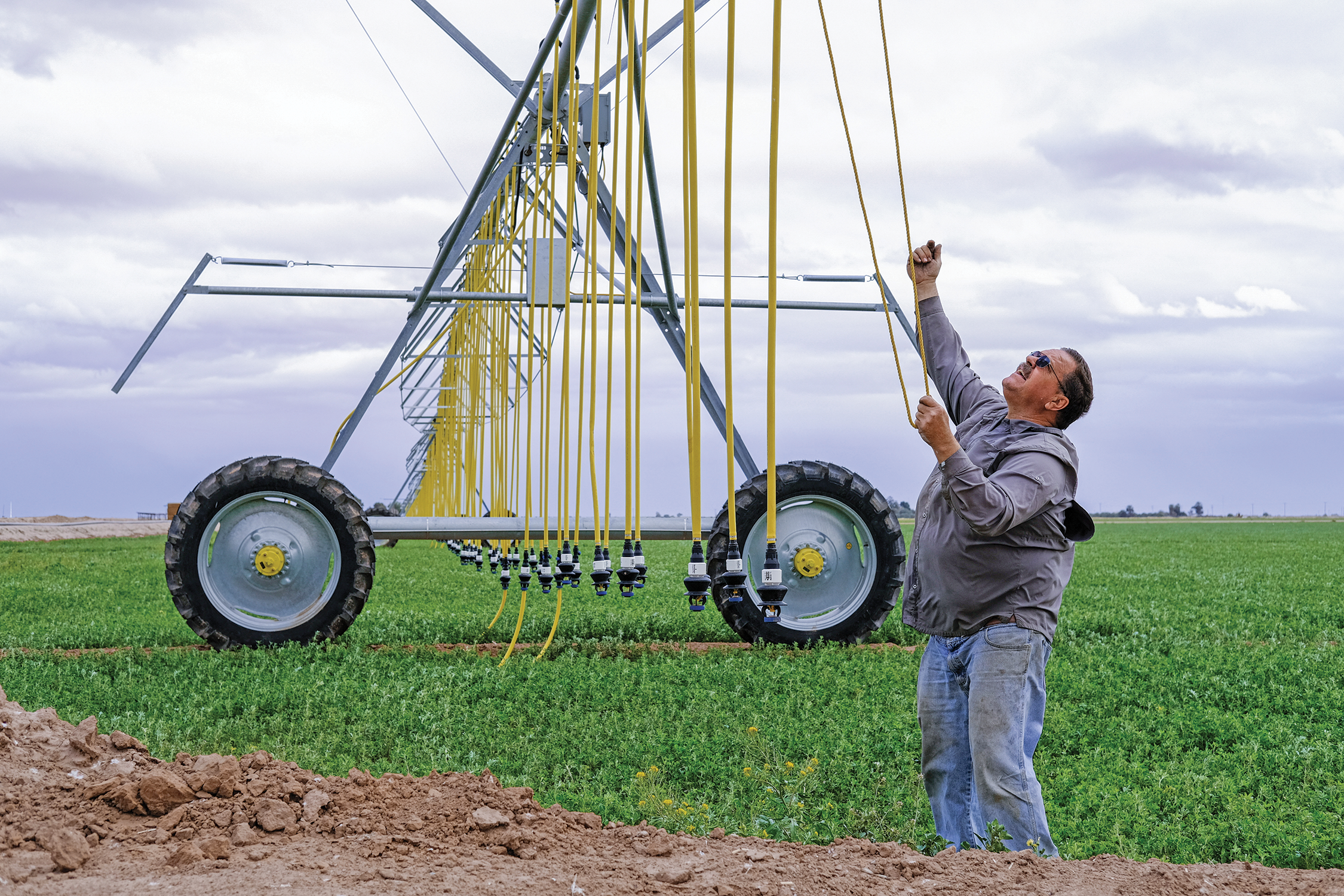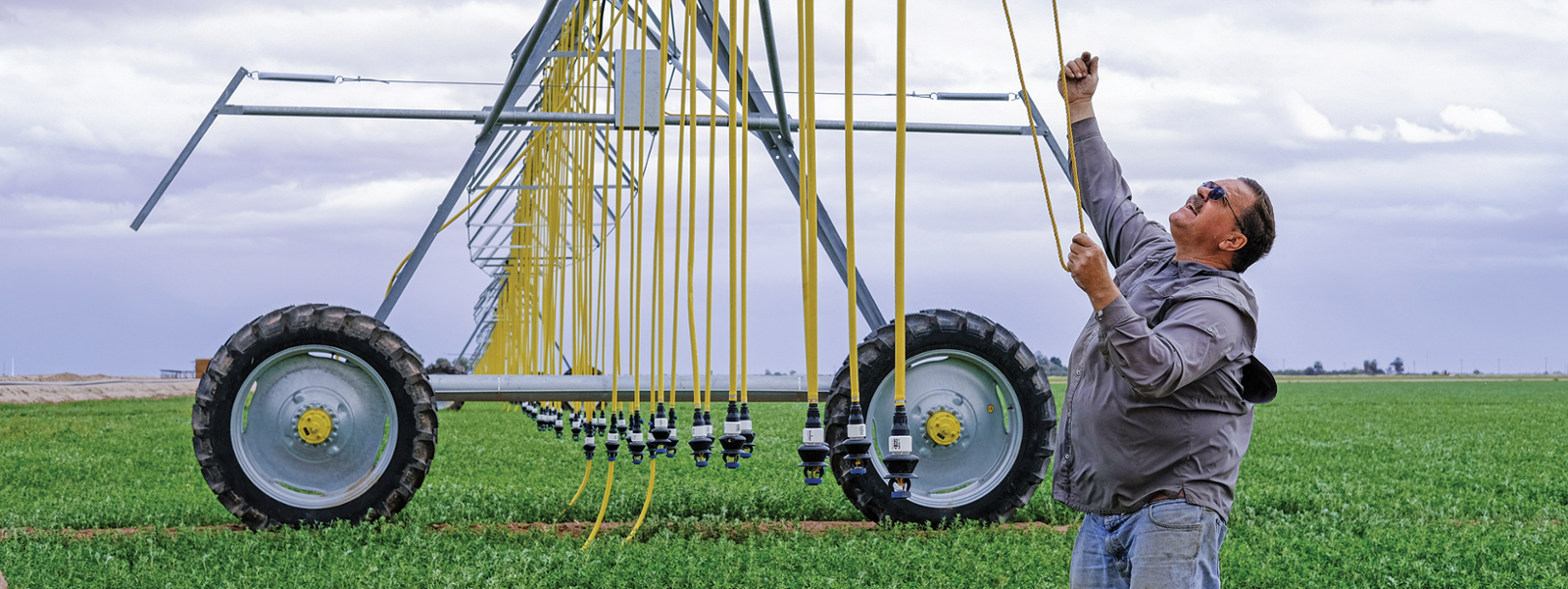Imperial Valley farmers await water deal

Over the past two decades, Imperial Valley farmers such as Ronnie Leimgruber have invested millions of dollars in efficient irrigation infrastructure. In March, Leimgruber worked on one of his linear hose-drag systems, which maximizes water efficiency by using hoses to irrigate fields of alfalfa.
Photo/Caleb Hampton


Photo/Caleb Hampton
By Caleb Hampton
California, Arizona and Nevada reached a long-sought consensus last month on how to conserve water and prevent the Colorado River from running dry.
Under the plan for states to reduce their water use by 13% through 2026, farmers in the Imperial Valley are expected to shoulder much of the burden.
But growers in the valley, who are entitled to more than a third of the water in the river’s Lower Basin, say they have had to delay plans to fallow crops and save water this summer. That’s because details on compensation have yet to be worked out between the Imperial Irrigation District and the federal government, which pledged to make $1.2 billion available for impacted water users.
The U.S. Bureau of Reclamation is negotiating with individual water users across the Lower Basin to determine how much each will be paid to leave water in the river.
“We have been pressuring them, saying our growers have cropping decisions to make, and we’re getting close to running out of time,” IID Water Manager Tina Shields said.
Finally, on June 1, IID officials told the Bureau of Reclamation it was too late for farmers to adjust their crop planning to implement new conservation programs. “It’s not going to happen in 2023,” Shields said.
With farmers in the Imperial Valley holding some of the most senior water rights on the Colorado River, the irrigation district cannot impose reductions on growers. “We operate voluntary conservation programs where we seek grower participation and provide funding, and then they make business decisions on whether or not that’s attractive,” Shields said.
But until growers have been told how much they will be paid for each acre-foot of water they save, they cannot calculate whether it is viable for them to forfeit crop revenue by drying up certain fields.
“Those are the things we’ve got to weigh and balance,” said Mark McBroom, who has farmed in the Imperial Valley for four decades and chairs IID’s Agricultural Water Advisory Committee, a group of 15 growers that advises the irrigation district.
“We’re playing the waiting game,” said Rachel Magos, executive director of the Imperial County Farm Bureau. “Growers are willing to be a part of the solution, but there will need to be some alignment as far as compensation goes in order to get the participation that is needed.”
Shields said in an interview last week that IID and the Bureau of Reclamation were “continuing to have ongoing discussions.” A spokesperson for the federal agency said it did “not have a timeline for the IID conservation agreement process.”
Since 2003, Imperial Valley farmers have used less water than they are allocated, transferring 16% of their entitlement to cities such as San Diego in exchange for funding they must use to build efficient irrigation systems. Under the proposed consensus plan to restore the Colorado River, Imperial Valley farms would forfeit another 8% of their water—about 250,000 acre-feet per year—by leaving it in the river.
McBroom, the committee chairman, said farmers were ready to make the additional cuts this year had a program been available. “We could have started this summer, but the BOR has not responded with the price of water,” he said. There are also permits, environmental analyses and other details that must be finalized before a conservation program begins.
“As of right now, there won’t be any changes to what we’re already doing,” McBroom said. “This additional amount of water, it won’t be coming this year.”
With the Lower Basin aiming to save 3 million acre-feet of water by 2026, Shields said deferring Imperial Valley programs that could have saved “a good chunk of water” this year was a missed opportunity. “It changes our overall potential,” she said.
The delay has frustrated farmers who hoped to begin replenishing Lake Mead, the massive reservoir fed by the Colorado River and only source of water for the valley and its $2.9 billion agriculture sector.
“Another year goes by, and the lake gets lower,” said farmer Mark Osterkamp, who grows alfalfa, carrots, onions and other crops. “They have to be more cognizant that if they’re going to ask us for water, there are timelines that are extremely important to a farmer.”
In the Imperial Valley, farmers generally make crop planning decisions for the year between early April and early June. “After that, it’s too late to change course,” Osterkamp said. “We can’t start working on a sugar beet crop in August.”
Most of the crops for the year are planted in September, and “it takes all summer long to prep the ground,” said Ronnie Leimgruber, a third-generation Imperial Valley farmer. This month, Leimgruber is disking out old crops, breaking up ground and flooding it to germinate weeds. “Then, you’ve got to disk it up again a month later and level it all back out and then shape your beds,” he said. “You can’t slow down because then you can never get caught up.”
In April, IID’s Agricultural Water Advisory Committee proposed a program in which farmers would stop watering alfalfa and other forage crops for a 60-day period in the summer. The concept, called deficit irrigation or temporary fallowing, is designed to save water by forfeiting one or two hay cuttings without killing the plant population in those fields.
During the Imperial Valley’s hot summers, alfalfa requires more water and produces lower yields of poorer quality. Locking the irrigation gates during that period can maximize water savings while minimizing production losses, explained Ali Montazar, University of California Cooperative Extension irrigation and water management advisor for Imperial, Riverside and San Diego counties.
However, the system also brings risks. “If we do a bad job, we can lose the plant stands and lose plant population,” said Montazar, who conducted a three-year study on deficit irrigation with Imperial Valley alfalfa farmers. “You need to be very careful on this.”
In recent years, the Imperial Valley has resisted using fallowing programs because of their impact on jobs and the local economy, but farmers said the 2026 deadline for Colorado River conservation means they will have to dry some fields.
“This is the program we have put up to get close to the quarter-million acre-feet per year that’s needed,” said McBroom, referring to the deficit irrigation program. “This is the quickest, easiest and most sure way to come up with that amount of water.”
There is also a possibility that additional fallowing programs will be needed “to ensure we can meet the annual targets for our piece of the conservation agreement,” Shields said. “It may be a necessary evil in the near-term to protect the system, to ensure we have a long-term water supply.”
When a conservation program is funded and approved, growers in the Imperial Valley emphasized that each farmer has a unique set of circumstances to weigh before participating.
Leimgruber, for example, has invested up to $5,000 per acre installing efficient irrigation systems, infrastructure that will sit idle if he does not plant his fields. “It makes no sense for us to fallow,” he said.
There are also long-term considerations.
“It’s taken three generations for my family to develop markets for the alfalfa that I plant,” Leimgruber said. “The three-year deal that the feds want is peanuts compared to a lifelong commitment and the relationships we’ve developed with our employees and our customers. We don’t want to lose all of that by fallowing for a year or two.”
For now, farmers in the Imperial Valley continue to discuss conservation strategies and wait on a funding deal.
“Once we know what the compensation is going to be for us to forgo irrigating our crops, providing for families and maintaining the community,” McBroom said, “then we’ll be able to tell you what we can do.”
(Caleb Hampton is an assistant editor of Ag Alert. He may be contacted at champton@cfbf.com.)




